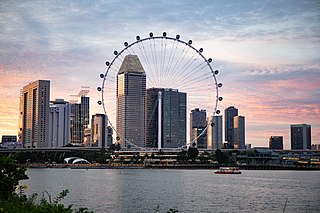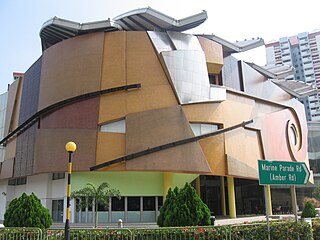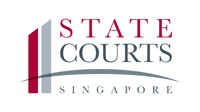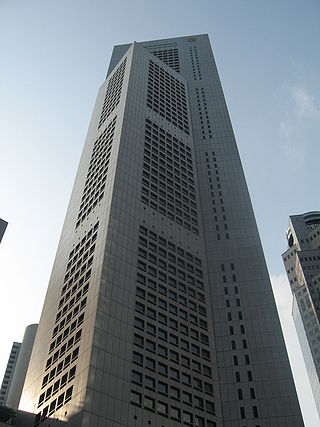
The Singapore River is a river that flows parallel to Alexandra Road and feeds into the Marina Reservoir in the southern part of Singapore. The immediate upper watershed of the Singapore River is known as the Singapore River Planning Area, although the western part of the watershed is classified under the River Valley planning area.
The following lists events that happened during 1999 in the Republic of Singapore.

The Former City Hall building in Singapore is a national monument gazetted on 14 February 1992. It can be found in front of the historical Padang and adjacent to the Former Supreme Court of Singapore, it was designed and built by the architects of the Singapore Municipal Commission, A. Gordans and F. D. Meadows from 1926 to 1929. A flight of stairs takes visitors from the Corinthian colonnade to the main building. The building was constructed to replace several houses designed by architect G.D. Coleman. It was first known as Municipal Building until 1951 when Singapore was granted city status by King George VI.

This article shows the notable future developments in Singapore. Most of them are currently under construction with most to be completed within the next five years.
Jin Long Si Temple is a temple located at 32 Tai Seng Avenue, Singapore.

Marine Parade Community Building was a community centre located at 278 Marine Parade Road, Singapore. Opened on 6 March 2000, it houses the formerly separate Marine Parade Community Centre and Marine Parade Public Library, as well as a performing arts group, The Necessary Stage. Designed by William Lim Associates, one of the distinguishing features of the postmodern building is the mural cladding called the "Texturefulness of Life", the largest piece of installation art in Singapore. It was demolished in 2022 and is being rebuilt.

International Plaza is a high-rise commercial and residential building at 10 Anson Road in Tanjong Pagar, within the Downtown Core of Singapore, next to Tanjong Pagar MRT station on the East West line.

The State Courts of Singapore is one of the three categories of courts in Singapore, the other categories being the Supreme Court and Family Justice Courts. The State Courts comprise the District and Magistrate Courts—both of which oversee civil and criminal matters—as well as specialised courts such as the coroner's courts and the Small Claims Tribunals.

One Raffles Place is a skyscraper in Downtown Core, Singapore. The development comprises two towers and a podium. The 280 m (920 ft) tall Tower One and the 38-storey Tower Two house offices, while the podium contains retail space. Initially conceived in the late 1970s as Overseas Union Bank Centre, the headquarters of Overseas Union Bank (OUB), work on the building began in 1981, while construction of the superstructure subsequently commenced in October 1984. Costing S$486 million to build, OUB Centre opened in two phases in June and December 1986, and 90% of its office space was occupied upon opening. At the time of its completion, The Business Times claimed that the complex's tower was the tallest in the world outside the United States.
The following lists events that happened during 1975 in Singapore.
The Princess House is a building on Alexandra Road in Queenstown, Singapore. The building was initially used as the offices for the Singapore Improvement Trust, and later became the first dedicated headquarters of the trust's successor, the Housing and Development Board.

60 Waterloo Street is a historic bungalow on Waterloo Street in downtown Singapore. A second four-storey building was constructed behind the bungalow when the Dance Ensemble Singapore moved into the bungalow in 1995.
Singapore Council of Women's Organisations Centre, also known as 96 Waterloo Street, is a historic bungalow on Waterloo Street in downtown Singapore. It currently houses the Singapore Council of Women's Organisations.
Red Cross House is a building on Penang Lane in Singapore which serves as the headquarters of the Singapore Red Cross Society.
321 New Bridge Road is a building on New Bridge Road in Chinatown, Singapore. It serves as the current premises of the Kong Chow Wui Koon clan, who moved into the building in 1924. It currently houses the Kong Chow Cultural Centre and previously housed the clan's Kong Chow School.

Teochew Building is a historic building on Tank Road in Singapore. Completed in 1963, it jointly houses the Teochew Poit Ip Huay Kuan and the Ngee Ann Kongsi.

The Warehouse Hotel is a boutique hotel housed in a row of three adjoining historic warehouses on Havelock Road within the Singapore River planning area. Completed in 1895, the building, which is "one of the oldest independently standing warehouses in Singapore", previously housed the Warehouse Disco, the country's largest discotheque.

Olson Building, also known as Block 11A or 29 Mount Sophia, is a historic building that was on the campus of the Methodist Girls' School on Mount Sophia in Singapore. It has since been repurposed as a condominium clubhouse.

Maxwell Chambers Suites, formerly known as the Traffic Police Headquarters or the Traffic Police Building, and later as the Red Dot Traffic Building, is a historic building on Maxwell Road in Chinatown, Singapore. It initially served as the Police Barracks and the headquarters of the Traffic Police branch of the Singapore Police Force, which moved into the building in 1930. In 1941, the first driving test centre in Singapore was established within the building. It ceased operations in 1978 to relieve congestion in the area.

Trinity Theological College Chapel is a building and former chapel in Mount Sophia, Singapore. Completed in 1969, it served as the chapel for the Trinity Theological College, which moved elsewhere in 2001. The building was later conserved and integrated into a condominium.













